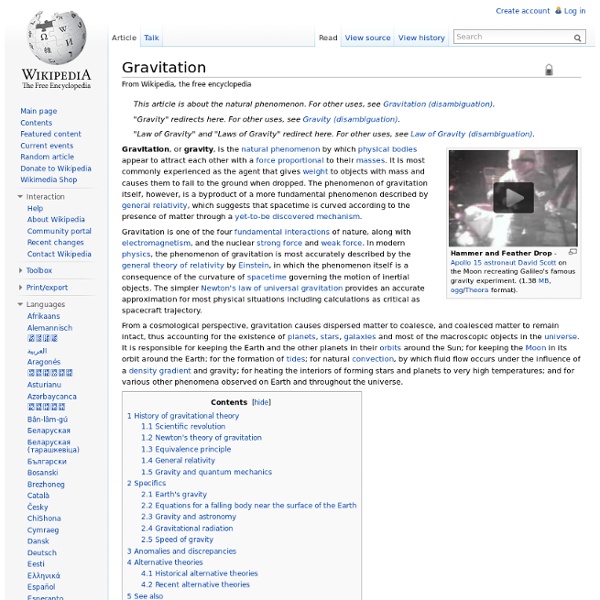Gravitation

Strong interaction
In particle physics, the strong interaction (also called the strong force, strong nuclear force, nuclear strong force or color force) is one of the four fundamental interactions of nature, the others being electromagnetism, the weak interaction and gravitation. At atomic scale, it is about 100 times stronger than electromagnetism, which in turn is orders of magnitude stronger than the weak force interaction and gravitation. It ensures the stability of ordinary matter, in confining the elementary particles quarks into hadrons such as the proton and neutron, the largest components of the mass of ordinary matter. Furthermore, most of the mass-energy of a common proton or neutron is in the form of the strong force field energy; the individual quarks provide only about 1% of the mass-energy of a proton[citation needed]. In the context of binding protons and neutrons together to form atoms, the strong interaction is called the nuclear force (or residual strong force). History[edit]
Weak interaction
In particle physics, the weak interaction is the mechanism responsible for the weak force or weak nuclear force, one of the four fundamental interactions of nature, alongside the strong interaction, electromagnetism, and gravitation. The weak interaction is responsible for both the radioactive decay and nuclear fusion of subatomic particles. The theory of the weak interaction is sometimes called quantum flavordynamics (QFD), in analogy with the terms QCD and QED, but in practice the term is rarely used because the weak force is best understood in terms of electro-weak theory (EWT).[1] During the quark epoch, the electroweak force split into the electromagnetic and weak force. History[edit] In 1933, Enrico Fermi proposed the first theory of the weak interaction, known as Fermi's interaction. However it is better described as a non-contact force field having a finite range, albeit very short. The existence of the W and Z bosons was not directly confirmed until 1983. Properties[edit]
Higgs boson
The Higgs boson is named after Peter Higgs, one of six physicists who, in 1964, proposed the mechanism that suggested the existence of such a particle. Although Higgs's name has come to be associated with this theory, several researchers between about 1960 and 1972 each independently developed different parts of it. In mainstream media the Higgs boson has often been called the "God particle", from a 1993 book on the topic; the nickname is strongly disliked by many physicists, including Higgs, who regard it as inappropriate sensationalism.[17][18] In 2013 two of the original researchers, Peter Higgs and François Englert, were awarded the Nobel Prize in Physics for their work and prediction[19] (Englert's co-researcher Robert Brout had died in 2011). A non-technical summary[edit] "Higgs" terminology[edit] Overview[edit] If this field did exist, this would be a monumental discovery for science and human knowledge, and is expected to open doorways to new knowledge in many fields. History[edit]
Related:
Related:



